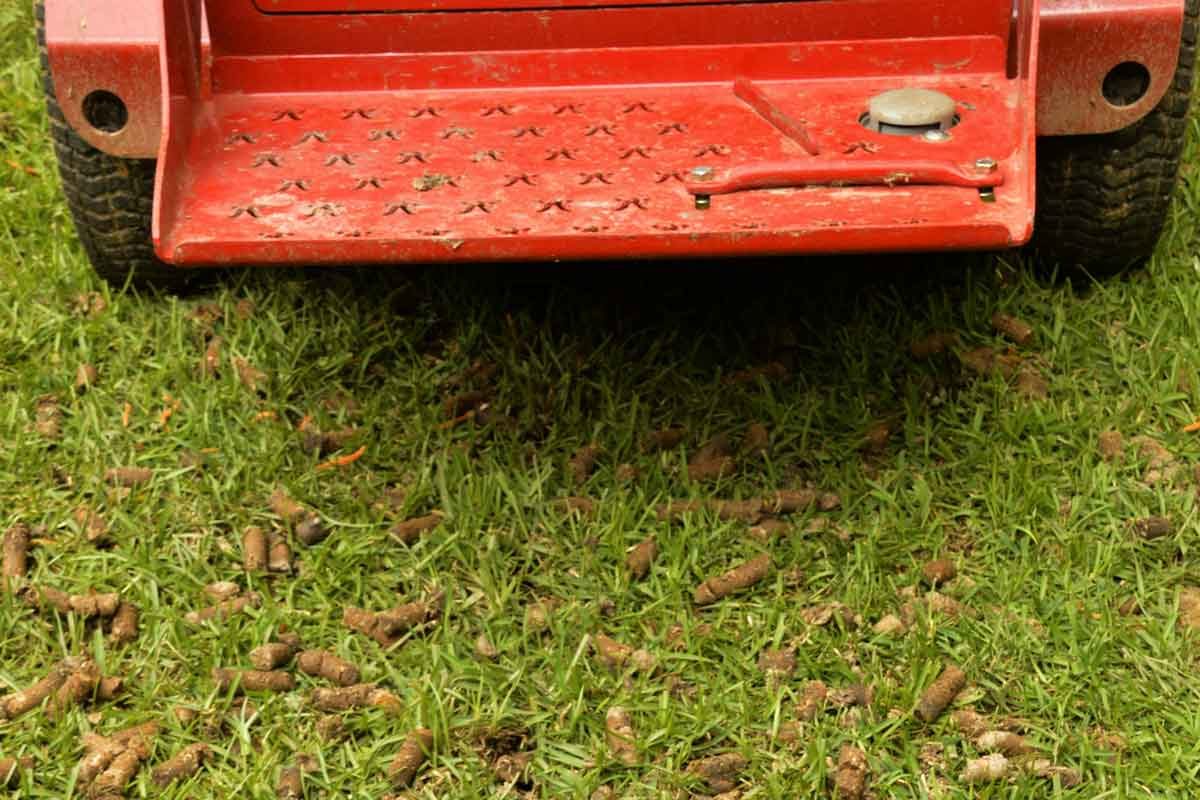Aerating is one of the most important lawn maintenance tasks, yet it's often overlooked. Here's why and when to aerate your lawn, and how to do it.

When, Why and How to Aerate the Lawn

You already know that your lawn requires mowing, watering, feeding and weeding to keep its lush appearance and to keep it away from any lawn diseases. To up your lawn care game, add lawn aeration to your fall yardwork checklist. You’ll see what a difference it makes.
On This Page
What Is Lawn Aeration?
Lawn aeration requires punching holes in your lawn’s surface, reducing surface compaction and allowing air to permeate the ground. These holes also create a path for water and fertilizer to easily reach the root zone beneath the turf, helping ensure a thick lawn.
There are different ways to aerate your lawn. A small lawn can be handled with a manual core aerator. This can be tedious, and you should wear thick-soled work boots to protect your feet from repetitively stepping on a metal bar.
The most effective way to aerate a lawn of any real size involves a machine with hollow coring tines. This type of aerator punches holes and removes soil cores from the ground.
Spike aerators and those with slicing knife blades, such as the Craftsman Tow Spike Aerator, are less effective. Many lawn owners like them because they don’t bring soil to the surface, which can cause a mess. However, these non-coring aerators are not as efficient at opening up the soil for nutrients and water to enter.
Don’t bother with aerator spikes you attach to shoes and wear around the yard. They don’t penetrate the ground enough to make a difference.
Why You Should Aerate Your Lawn
Heavy recreational use, active pets, foot traffic and even lawnmowers can compact the soil under your lawn. That impedes root growth and can lead to thatch, a combination of slowly decomposing grass stems, roots and debris that gradually accumulates at the soil surface and keeps water from penetrating.
Aerating regularly helps build healthier soil and limits thatch build-up, so air, water, nutrients and even grass seed can reach the root zone.
How To Aerate Your Lawn
Lawn aerators, power rakes and other power equipment can be found at a local tool rental store, many hardware stores and some big box retailers. Renting one will set you back around $60 to $75 for a half day.
Aerators are heavy by design, so have a truck and some extra hands available. Consider banding together with neighbors to rent one for the day and save money. Here’s how to aerate your lawn:
- Flag utilities. If you have an irrigation system, start by flagging your sprinkler heads. This will prevent unnecessary damage and costly repairs should you hit one.
- Time your aeration. Aerate when the ground is soft, like after an irrigation cycle or a recent rainfall. This allows the tines to penetrate the ground easier and deeper. Hollow- and solid-core aerator tines struggle to penetrate hard, dry soil, making the process less effective.
- Be thorough. Go over your entire lawn at least once, preferably twice, the second time at a cross angle. Lawn surfaces adjacent to driveways, sidewalks and other heavily trafficked spots should always get several passes.
- Wait. Allow the soil cores lying on the surface to dry. Then break them up with a bow rake, like the Bully Tools 12-Gauge, 16-Inch Bow Rake; a drag mat, like the Yard Turf 5×3 Drag Mat; or a power rake. Even a quick pass with your lawnmower will do it, but be careful: This may dull your mower blade, requiring it to be resharpened. Soil from the broken cores will find its way back into the grass, thatch layer and holes, acting as a light top dressing that helps smooth your lawn’s surface and slow the development of thatch.
What Is the Best Time to Aerate a Lawn?
Late summer and fall is the optimum season. Why fall? Blame it on summer. That’s when many lawns become compacted from heightened activity, foot traffic and dry weather. Fall aeration alleviates the compaction, preparing the soil to grow healthy grass the following spring.
Spring aeration is an alternative, but if you aerate in the spring, you could unearth weed seeds and cause unnecessary weed growth. And if you’re applying a crabgrass preventer in spring, punching holes in your lawn after treating with a pre-emergent herbicide can compromise the chemical barrier it creates to prevent crabgrass and other weeds.
The absolute worst time to aerate is during hot, dry weather, which could quickly dry out the grass, causing undue stress to your lawn.
What Should You Do After Aerating Your Lawn?
Whenever possible, combine lawn aeration with other lawn care maintenance, such as fertilizing, adding soil amendments or overseeding. Water, fertilizer and grass seed all need to get through the lawn surface and into the soil to do their job. Creating a path for them to get there can be accomplished by core aerating. An application of fertilizer immediately after core aeration will also help restore your lawn.




















